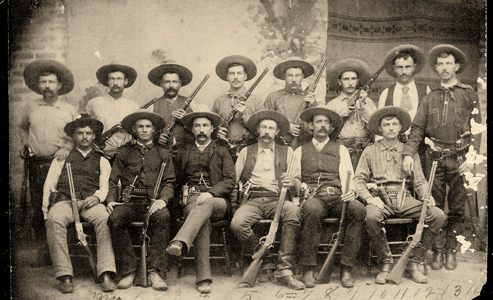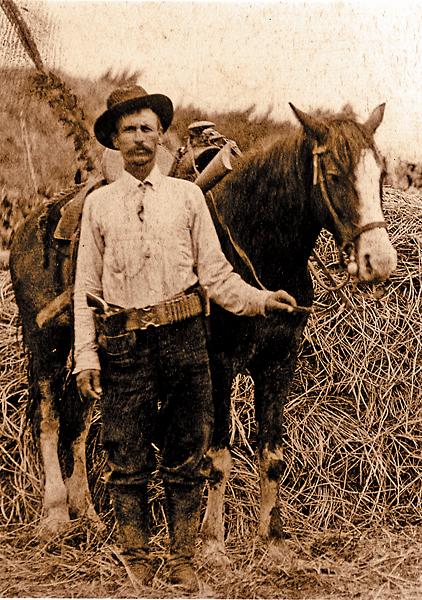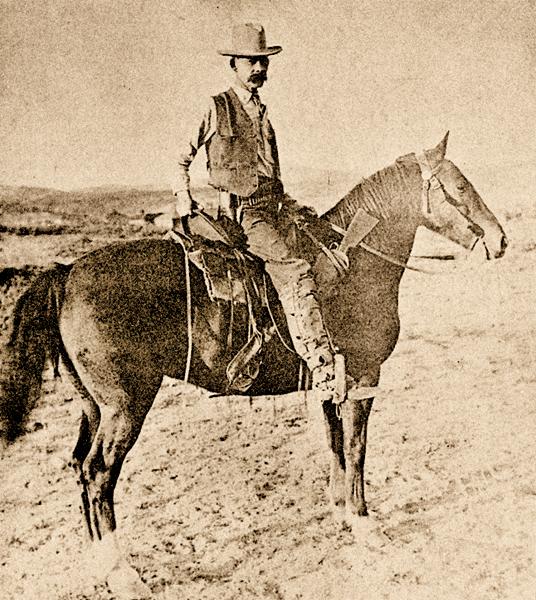 We feel fortunate to have photographs of Wyatt Earp, Bat Masterson and Dallas Stoudenmire, but, as far as we know, none of the aforementioned were captured on film while wearing their guns (true, the Dodge City photo of Earp and Masterson may include weapons, but we can’t see them).
We feel fortunate to have photographs of Wyatt Earp, Bat Masterson and Dallas Stoudenmire, but, as far as we know, none of the aforementioned were captured on film while wearing their guns (true, the Dodge City photo of Earp and Masterson may include weapons, but we can’t see them).
Because of this unfortunate paucity when it comes to some of our top lawmen of the frontier West, we’re always amazed when we find images that portray lawmen armed to the teeth and ready for bear. To bring you an authentic look of what some outlaws and scoundrels saw at the other end of the barrel, we have rounded up the best photographs of lawdogs ready for the hunt and the back trail.
Here they are, in all their six-gun glory. We trust more of these armed and dangerous frontier lawmen are waiting to be discovered in someone’s photo album, but until we find them, feast your eyes on these classics.
Photo Gallery
Shown here in his buffalo hunting days, Bill Tilghman (at left) was approached by Bat Masterson to serve as a deputy sheriff from 1878, a job he served admirably until 1884, which earned him the respect to work in various law enforcement jobs for the rest of his life. He’s best known for single-handedly capturing Bill Doolin in 1895. He also rose to fame as part of the
Charles A. Siringo missed his chance at fame when Pat Garrett tracked down Billy the Kid without his help. He made up for it, though, by striking hot on the trail after Butch Cassidy and the Wild Bunch during his 20 years working as a Pinkerton “cowboy” detective.
– Courtesy Robert G. McCubbin Collection –
While working as sheriff of Arizona’s Apache County, Commodore Perry Owens earned fame for his 1886 shoot-out in Holbrook, where he killed three of the Blevins crew and wounded a fourth in five shots. He went on to become the first sheriff of Navajo County from 1895-96. What we love most about this photo is the fact that Owens is wearing a buscadero rig, a holster style rarely seen in Old West photographs.
– Courtesy Robert G. McCubbin Collection –
What a resourceful lawman. This officer from Trinidad, Colorado, recovered a torn envelope, pasted the pieces together and used that information to track the Black Jack Ketchum Gang to Cimarron, New Mexico.≤p≥≤i≥– True West Archives –
Deputy Marshal Heck Thomas’s dogged pursuit of the Dalton Gang may have contributed to the Coffeyville debacle that led to the gang’s demise. At least, Wells Fargo believed as much, telling Thomas (seated front row, at left), “We feel that your work, more than anything, brought about the extermination of this gang.” The gang members weren’t shy about their fear of this lawdog either, with Emmett Dalton admitting he saw Thomas as his “nemesis.”
– Courtesy Robert G. McCubbin Collection –
Joe LeFors made his name as a lawman after he duped a drunken Tom Horn into basically confessing to the murder of teenager Willie Nickell. Yet it was his pursuit of Kid Curry, the Sundance Kid and other gang members after a 1900 train robbery in Tipton, Wyoming, that would make Lefors the inspiration for the leader of the so-called “super posse” that tracked the Wild Bunch so tenaciously in 1969’s Butch Cassidy and the Sundance Kid.
– Courtesy Chip Carlson –
A figure of stealth and violence, John Selman famously killed gunfighters John Wesley Hardin and Bass Outlaw. Before Outlaw died in that 1894 gunfight, he did send a bullet to Selman’s leg that led him to use a cane for the rest of his life.
– True West Archives –
Texas Deputy U.S. Marshal Edward W. Johnson (at left) lost his right arm in an 1888 gunfight soon after this photograph was taken. He gained notoriety after an 1889 mob attacked the notorious Marlow Brothers during a jail transport, an incident that inspired the 1965 film Sons of Katie Elder. What we love most about this photo are the different styles of lawman badges worn by him, Texas Ranger Lorenzo K. Creekman (center) and Parker County Deputy Sheriff E.A. Hutchison (at right).
– Courtesy George T. Jackson Jr. –
This six-foot-four Cherokee lawman participated in numerous gunfights from the 1870s and into the 1890s. His fearlessness brought him up the chain of command: Fort Smith posseman, Cherokee Nation deputy sheriff and deputy warden, deputy U.S. marshal, captain of the U.S. Indian Police. Someone should make a movie about this unsung hero.
– Courtesy Robert G. McCubbin Collection –
Yavapai County Sheriff Buckey O’Neill (third from left) had his horse shot out from under him during a gunfight near Wah Weep Canyon in Utah, yet he and his posse still scared the outlaws into surrendering. Those bad men were four cowboys who had robbed an Atlantic & Pacific train at Canyon Diablo Station, a railhead that serviced Prescott, Arizona.
– Courtesy Sharlot Hall Museum –
How fitting that the 1887 Winchester was created the same year that Texas John Slaughter became Cochise County sheriff. He handsomely wields that scattergun in this photograph, while he also packs his pearl-handled Colt Peacemaker. His Arizona peers called him Texas John because of his years working as a Texas Ranger.
– Courtesy Robert G. McCubbin Collection –
Ira Aten is definitely armed to the teeth in this 1887 photo. Notice his knife and pistol on the same side. Several Texas Ranger photos seem to show this preference, perhaps to favor the best hand in a fight?
– True West Archives –
This group of Company D Texas Rangers might lull you into thinking they’ve let down their defenses, but one look at that back row, particularly Ernest Rogers, with that fiery stare and his finger seemingly on the trigger, and you’re reminded that these men mean business. (Standing from left) Jim King, Bass Outlaw, Riley Boston, Charley Fusselman, Tink Durbin, Ernest Rogers, Charles Barton and Walter Jones. (Seated, from left) Bob Bell, Cal Aten, Captain Frank Jones, J. Walter Durbin, Jim Robinson and Frank L. Schmid.
– Courtesy Texas Ranger Research Center; Texas Ranger Hall of Fame & Museum –/i>
You can tell Company D had several of the most prominent Texas Rangers around—these lawdogs are eating their meals with Winchester repeaters on their lap, ready for them to grab at any sign of trouble. Their leader, Sgt. Ira Aten, stands above his Rangers (seated, from left): Jim King, Frank L. Schmid, Ernest Rogers, Cal Aten, Walter Jones, Charley Fusselman, J. Walter Durbin, Jim Robinson, John R. Hughes and Bass (Baz) Outlaw.
– Courtesy Jeri and Gary Boyce Radder –
The Union Pacific organized this posse to chase the Wild Bunch bandits after the 1900 train robbery holdup in Tipton, Wyoming. The posse car that transported these assorted lawmen was a retrofitted baggage car equipped with ramps so that posses and their mounts could quickly reach the robbery scene.≤p≥≤i≥– Courtesy Robert G. McCubbin Collection –





















